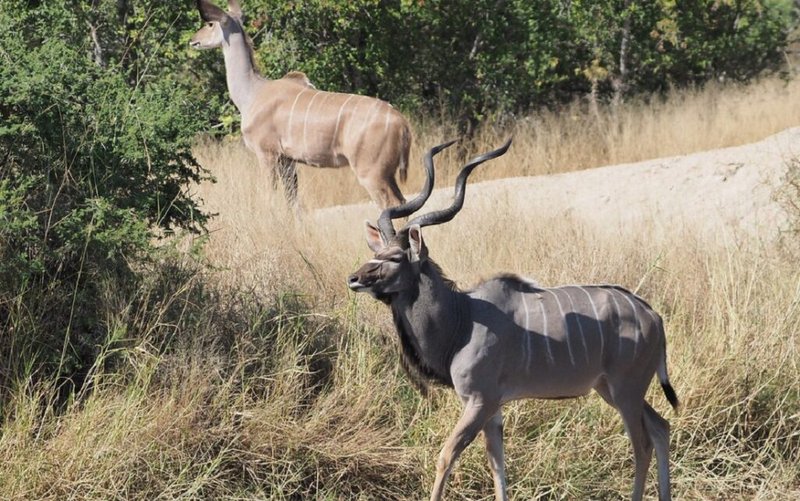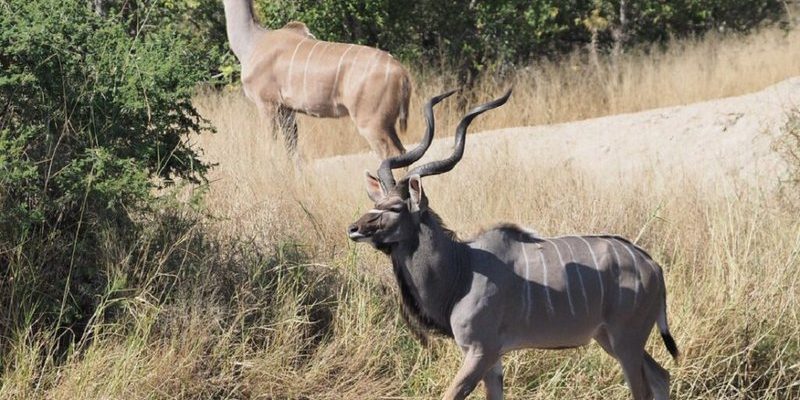
Kudus are more than just beautiful animals; they play a vital role in their ecosystem. They’re herbivores that help maintain the balance of plants in their habitat. However, habitat loss and poaching threaten their survival. So, let’s explore the status of the kudu, what’s causing their decline, and what’s being done to help them survive.
Understanding Kudu Species
Kudus are divided into two main species: the greater kudu and the lesser kudu. The greater kudu is larger, usually weighing between 400 to 600 pounds. It’s recognized for its impressive horns, which can reach up to 6 feet long in males. The lesser kudu, on the other hand, is smaller, weighing around 90 to 120 pounds and sporting shorter, more twisted horns.
You can find these animals across various regions of southern and eastern Africa. They thrive in savannas, woodlands, and bushy areas. Their incredible agility allows them to leap over obstacles with ease—an impressive skill considering their size! However, their distinct habitats are at risk due to human activities like agriculture and urban development.
The Kudu’s Conservation Status
So, are kudus endangered? The good news is that neither species is classified as endangered. The International Union for Conservation of Nature (IUCN) lists the greater kudu as “Near Threatened” and the lesser kudu as “Least Concern.” This means they’re not currently at the brink of extinction, but they’re not out of the woods yet.
The greater kudu, in particular, faces a rising number of challenges. Overhunting and habitat loss are significant concerns. As humans expand their reach into wilderness areas, kudus lose their homes and the safe spaces vital for their survival. Conservationists are working hard to combat these threats, but the struggle is ongoing.
Threats to Kudu Populations
Kudus encounter a variety of threats in their natural habitat. Let’s break down the main issues:
- Habitat Loss: As more land is cleared for agriculture, kudus lose the bushy areas they need for shelter and food.
- Poaching: Illegal hunting for meat and hunting trophies poses a significant risk. Kudus are often targeted due to their impressive antlers.
- Human-Wildlife Conflict: As kudus wander into agricultural areas looking for food, they can become unwitting pests, leading to retaliation from farmers.
These threats highlight the delicate balance between wildlife conservation and human needs. Honestly, it’s a complicated issue that requires understanding and cooperation from all parties involved.
Conservation Efforts for Kudus
Various organizations are stepping up to protect the kudu. Efforts range from habitat restoration to anti-poaching initiatives. For instance, conservation groups work on community-based programs that involve local people in protecting wildlife. This approach not only helps the kudus but also provides economic benefits to communities who might otherwise turn to poaching.
Additionally, wildlife reserves and national parks play a critical role in safeguarding kudu populations. Protected areas offer kudus a safe haven, ensuring they can thrive without the constant threat of human encroachment. Some parks even implement strict anti-poaching measures, using innovative technology to track and monitor wildlife movements.
Community Involvement and Education
Education is also a powerful tool in conservation. By informing local communities about the importance of kudus and their role in the ecosystem, conservationists can foster respect and care for these animals. This awareness often leads to community-led conservation projects, creating a sense of ownership over local wildlife.
For example, schools can introduce programs that teach children about the kudu’s habitat and behaviors. Engaging the younger generation is key; they’ll be the future stewards of these magnificent creatures.
What Can You Do to Help?
You might be wondering how you can contribute to kudu conservation from wherever you are. Here are some simple ways to make a difference:
- Support Conservation Organizations: Consider donating to or volunteering with groups that focus on wildlife conservation.
- Spread Awareness: Talk about the issues kudus face and share information on social media to educate others.
- Visit Sustainable Tourism Projects: When traveling, opt for eco-friendly tours that contribute to local conservation efforts.
Each small action can create a ripple effect, helping to protect these beautiful animals and their habitats.
Final Thoughts on Kudu Conservation
While the kudu is not currently classified as endangered, it faces numerous challenges that put its future at risk. The combined efforts of conservationists, local communities, and visitors can make a world of difference in ensuring that these stunning animals continue to roam the African plains.
By raising awareness and supporting conservation initiatives, we can all play a part in the survival of the kudu. After all, every creature has a role to play in our ecosystem, and kudus are no exception. So, let’s commit to protecting these incredible animals for generations to come.

